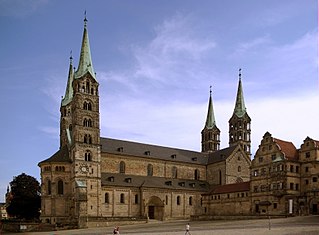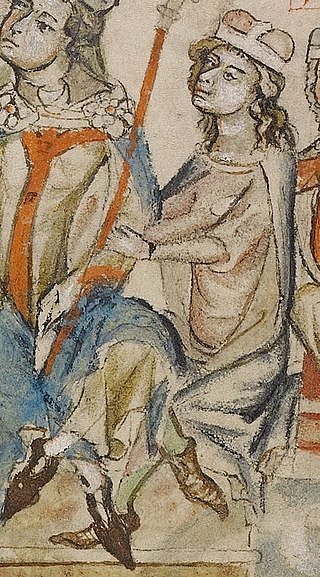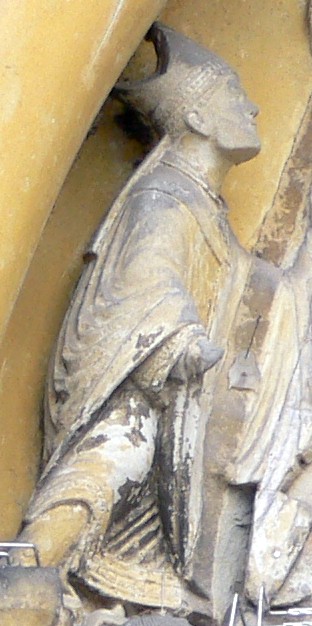This article includes a list of general references, but it lacks sufficient corresponding inline citations .(December 2013) |
| Bamberg Free state of Bavaria | |
|---|---|
 | |
| Emblazoning | |
|
The coat of arms of the city of Bamberg shows Saint George. [1]
This article includes a list of general references, but it lacks sufficient corresponding inline citations .(December 2013) |
| Bamberg Free state of Bavaria | |
|---|---|
 | |
| Emblazoning | |
|
The coat of arms of the city of Bamberg shows Saint George. [1]
Saint George is seen as the patron of the Cathedral chapter. He can be recognized by the St George's Cross upon his chest and the banner. It is said that the shield belongs to the noble family Andechs-Merania. [1]
Saint George has two roles in this setting. He is charge for the coat of arms of the city of Bamberg and Supporter for the coat of arms of the counts of Andechs-Merania.
First uses of the coat of arms in form of a seal are known since 1279. Across the years the charge changed: in the 14th century it was Heinrich II. Whereas in 15th and 16th century the "Bamberger Löwe" can be found, before again Saint George was used again. Also in the shield the eagle was replaced by a lion or the shield was missing completely. [1]
Lichtenfels is a Landkreis (district) in Bavaria, Germany. It is bounded by the districts of Coburg, Kronach, Kulmbach, Bayreuth and Bamberg.

Hof is a town on the banks of the Saale in the northeastern corner of the German state of Bavaria, in the Franconian region, at the Czech border and the forested Fichtel Mountains and Franconian Forest upland regions. The town has 47,296 inhabitants, the surrounding district an additional 95,000.

In heraldry, an escutcheon is a shield that forms the main or focal element in an achievement of arms. The word can be used in two related senses. In the first sense, an escutcheon is the shield upon which a coat of arms is displayed. In the second sense, an escutcheon can itself be a charge within a coat of arms.
Louis I, called the Kelheimer or of Kelheim, since he was born and died at Kelheim, was the Duke of Bavaria from 1183 and Count Palatine of the Rhine from 1214. He was the only surviving son of Otto I, Duke of Bavaria by his wife Agnes of Loon. He married Ludmilla of Bohemia, a daughter of Duke Frederick of Bohemia.

Bamberg Cathedral is a church in Bamberg, Germany, completed in the 13th century. The cathedral is under the administration of the Archdiocese of Bamberg and is the seat of the its archbishop. Since 1993, the cathedral has been part of the UNESCO World Heritage Site "Town of Bamberg".

The lion is a common charge in heraldry. It traditionally symbolises courage, nobility, royalty, strength, stateliness and valour, because historically the lion has been regarded as the "king of beasts". The lion also carries Judeo-Christian symbolism. The Lion of Judah stands in the coat of arms of Jerusalem. Similar-looking lions can be found elsewhere, such as in the coat of arms of the Swedish royal House of Bjelbo, from there in turn derived into the coat of arms of Finland, formerly belonging to Sweden.

Berthold IV, a member of the House of Andechs, was Margrave of Istria and Carniola. By about 1180/82 he assumed the title of Duke of Merania, referring to the Adriatic seacoast of Kvarner which his ancestors had conquered in the 1060s and annexed to Istria and Carniola.

Stadelhofen is a municipality in the Upper Franconian district of Bamberg and a member of the administrative community (Verwaltungsgemeinschaft) of Steinfeld.
Otto III, a member of the House of Andechs, was Count of Burgundy from 1231 and the last duke of Merania from 1234 until his death.

Otto I, a member of the House of Andechs, was Duke of Merania from 1204 until his death. He was also Count of Burgundy from 1208 to 1231, by his marriage to Countess Beatrice II, and Margrave of Istria and Carniola from 1228 until his death.

The House of Andechs was a feudal line of German princes in the 12th and 13th centuries. The counts of Dießen-Andechs obtained territories in northern Dalmatia on the Adriatic seacoast, where they became Margraves of Istria and ultimately dukes of a short-lived imperial state named Merania from 1180 to 1248. They were also self-styled lords of Carniola.

Attributed arms are Western European coats of arms given retrospectively to persons real or fictitious who died before the start of the age of heraldry in the latter half of the 12th century. Once coats of arms were the established fashion of the ruling class, society expected a king to be armigerous. Arms were assigned to the knights of the Round Table, and then to biblical figures, to Roman and Greek heroes, and to kings and popes who had not historically borne arms. Individual authors often attributed different arms for the same person, although the arms for major figures eventually became fixed.

German heraldry is the tradition and style of heraldic achievements in Germany and the Holy Roman Empire, including national and civic arms, noble and burgher arms, ecclesiastical heraldry, heraldic displays and heraldic descriptions. German heraldic style is one of the four major broad traditions within European heraldry and stands in contrast to Gallo-British, Latin and Eastern heraldry, and strongly influenced the styles and customs of heraldry in the Nordic countries, which developed comparatively late. Together, German and Nordic heraldry are often referred to as German-Nordic heraldry.

Agnes of Rochlitz came from the Wettin family and was daughter of Dedi III, Margrave of Lusatia and his wife, Matilda of Heinsburg. She is also known as Agnes of Wettin.

A number of cross symbols were developed for the purpose of the emerging system of heraldry, which appeared in Western Europe in about 1200. This tradition is partly in the use of the Christian cross an emblem from the 11th century, and increasingly during the age of the Crusades. Many cross variants were developed in the classical tradition of heraldry during the late medieval and early modern periods. Heraldic crosses are inherited in modern iconographic traditions and are used in numerous national flags.

Henry II, Margrave of Istria, born c.1175 and died 18 July 1228 in Slovenj Gradec (Windischgraz), was a noble from the House of Andechs who ruled the March of Istria and Carniola from 1204 to 1228. He inherited the County of Stein, and expanded his domains to the Windic March through marriage. He died childless, and his vast possessions were eventually inherited by his niece Agnes of Merania.

The Duchy of Merania was a fiefdom of the Holy Roman Empire from 1152 until 1248. The dukes of Merania were recognised as princes of the Empire enjoying imperial immediacy at a time when these concepts were just coming into use to distinguish the highest ranks of imperial nobility.

Heraldry is the system of visual identification of rank and pedigree which developed in the European High Middle Ages, closely associated with the courtly culture of chivalry, Latin Christianity, the Crusades, feudal aristocracy, and monarchy of the time. Heraldic tradition fully developed in the 13th century, and it flourished and developed further during the Late Middle Ages and the Early Modern period. Originally limited to nobility, heraldry is adopted by wealthy commoners in the Late Middle Ages. Specific traditions of Ecclesiastical heraldry also develop in the late medieval period. Coats of arms of noble families, often after their extinction, becomes attached to the territories they used to own, giving rise to municipal coats of arms by the 16th century.

Ekbert of Andechs-Meranien was bishop of Bamberg, Germany from 1203 until his death. He was the son of Berthold IV, Duke of Merania and Agnes of Rochlitz, and a brother of Saint Hedwig of Silesia and Gertrude of Merania, Queen of Hungary.